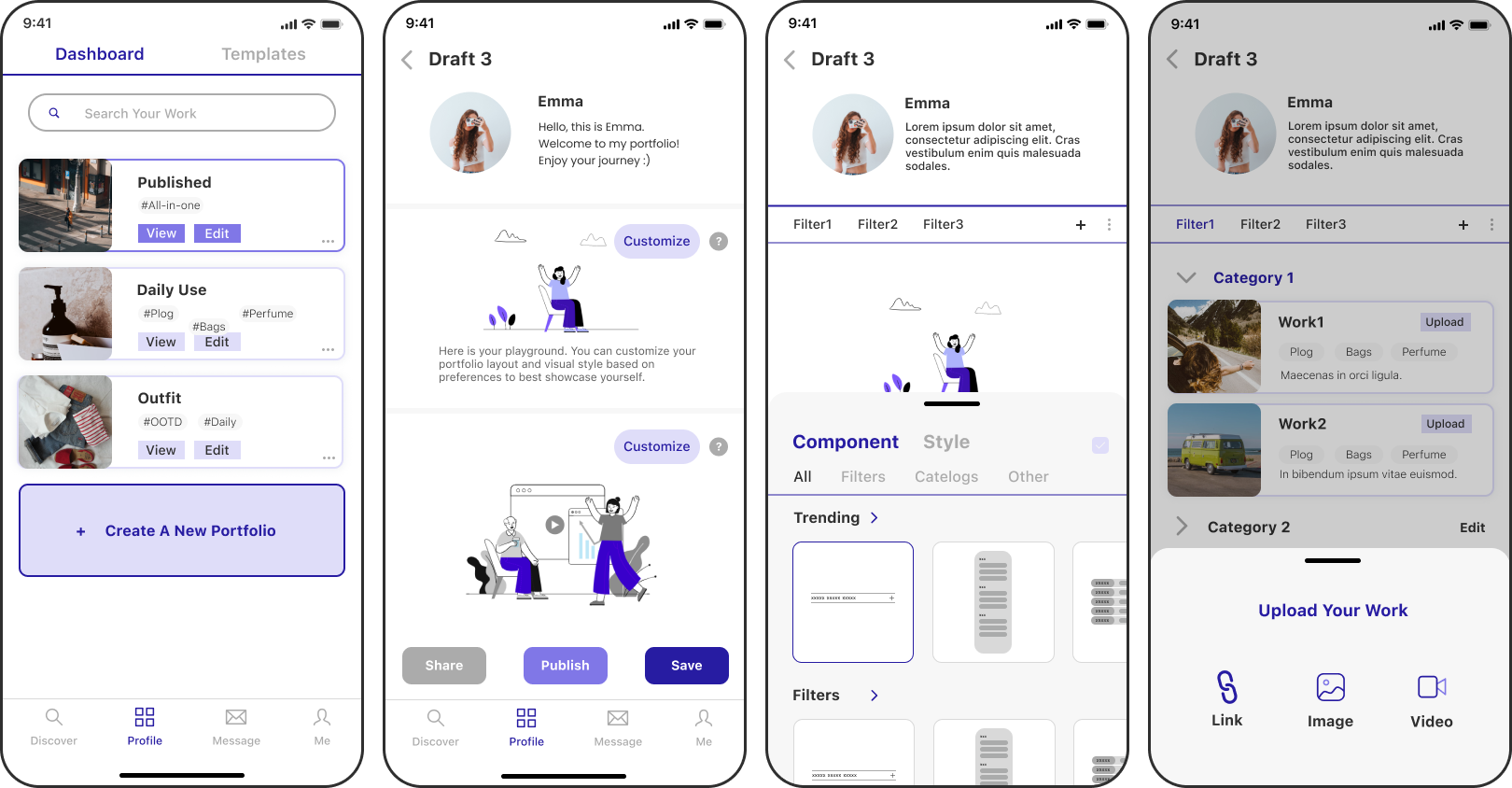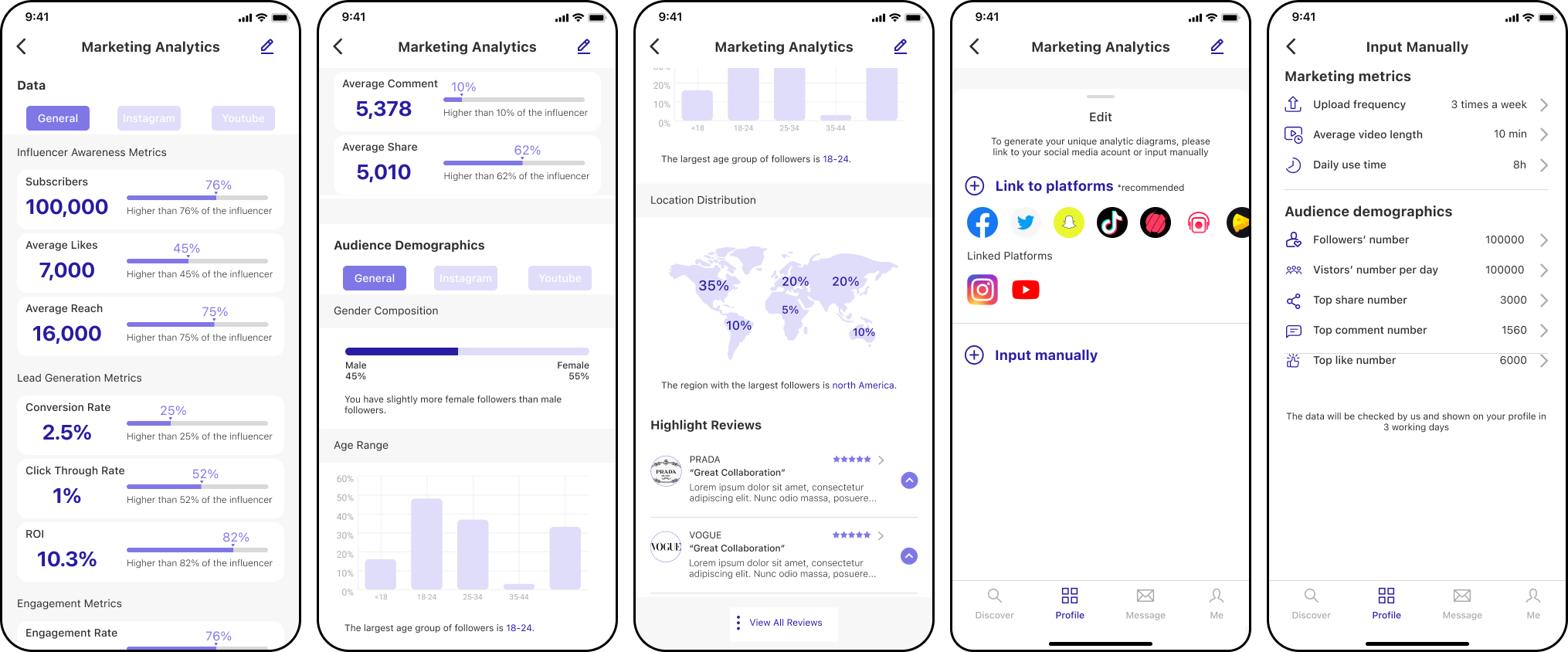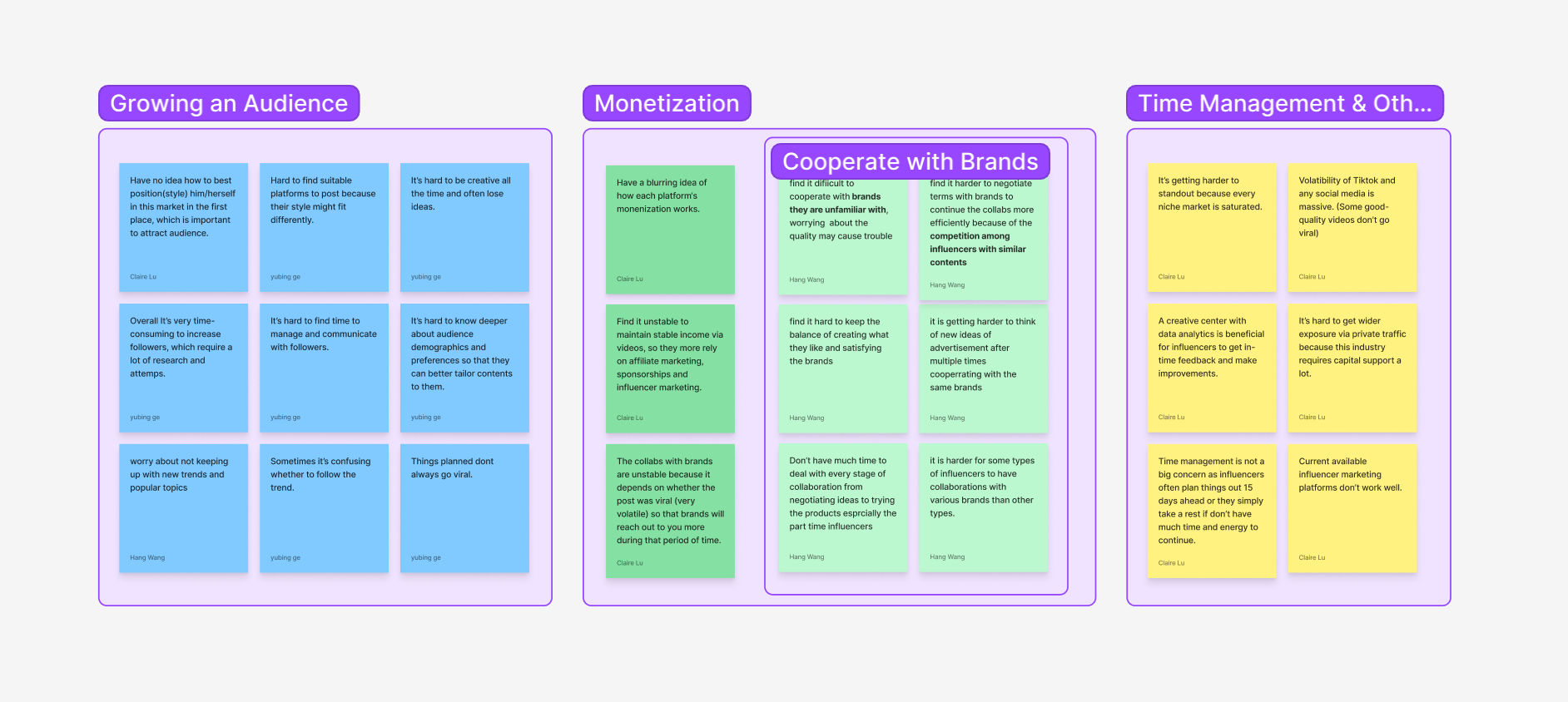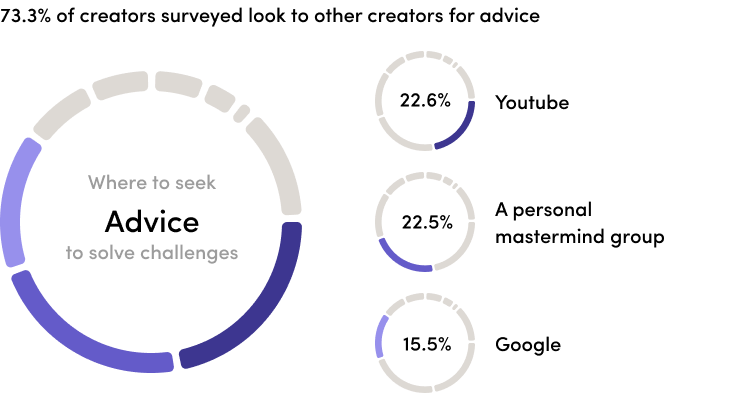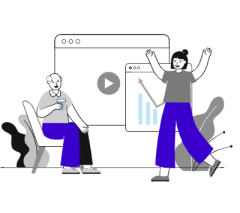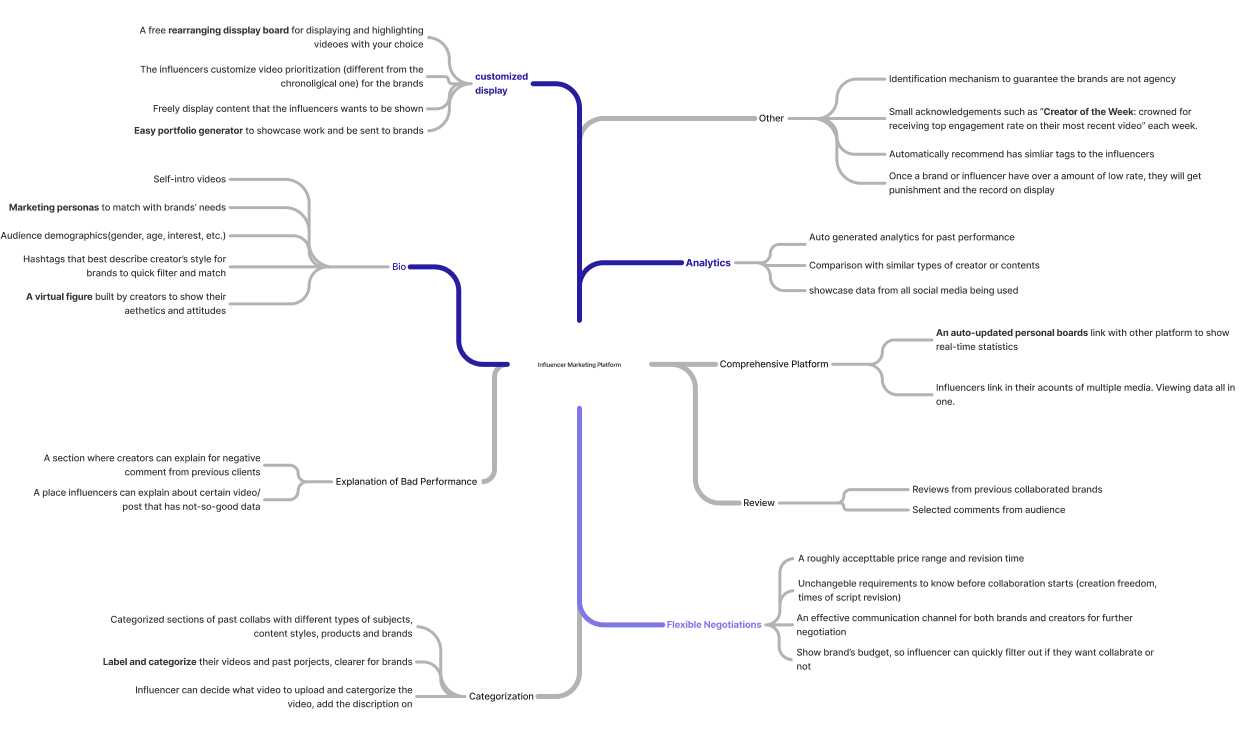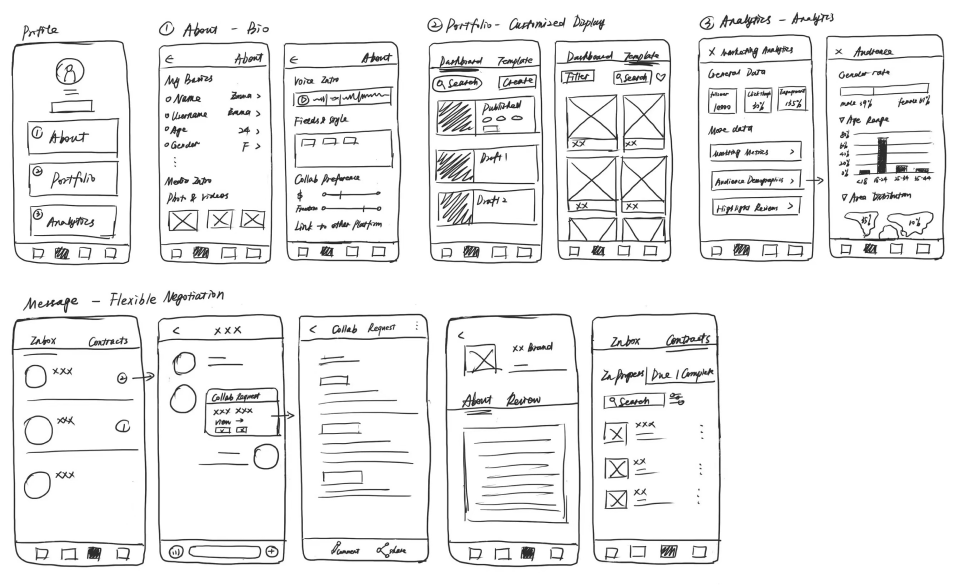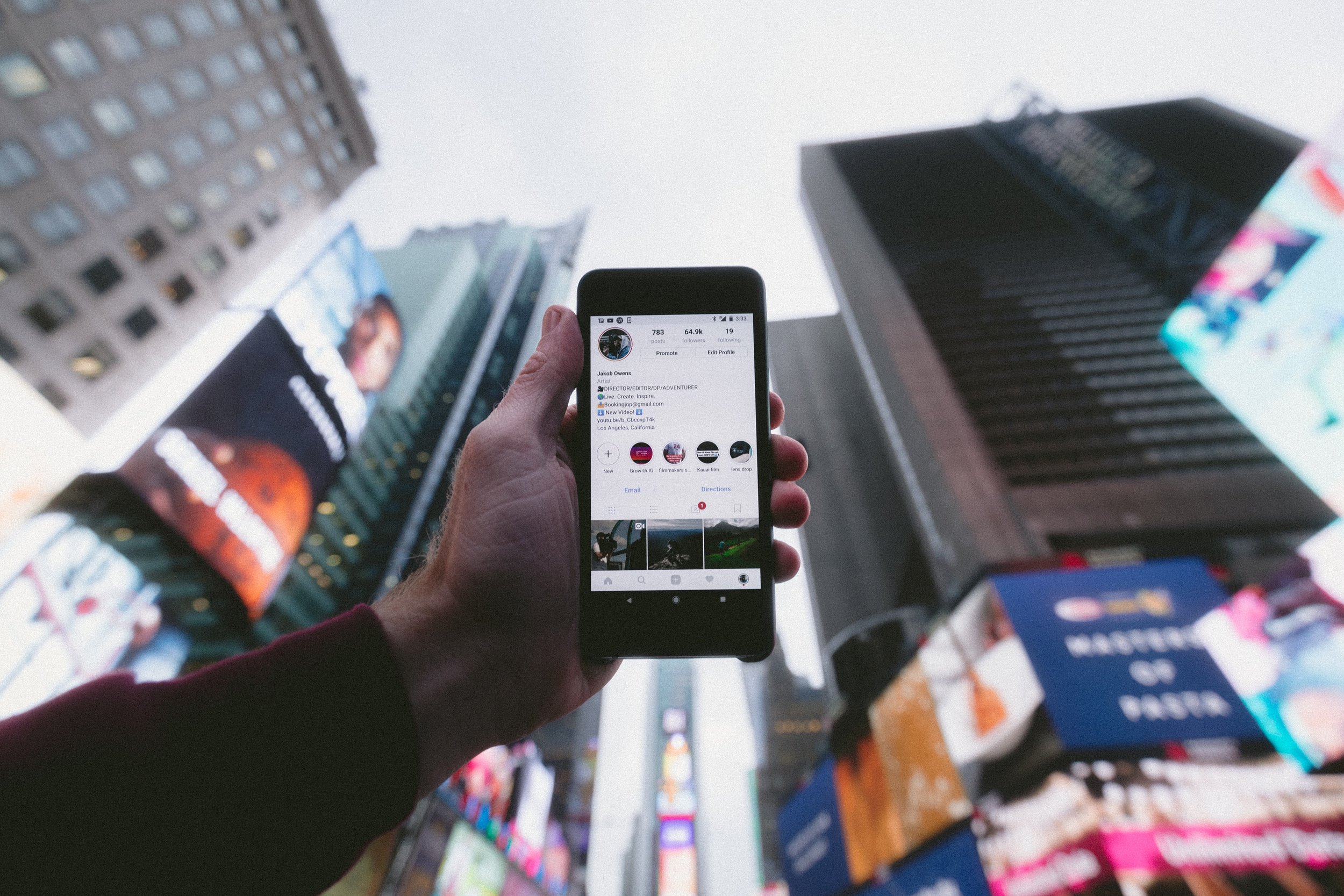
Popul
A portfolio platform to help mid-tier and micro-influencers attract and facilitate business collaboration process
It’s my first UX project.
Big thanks to our mentor and teammates! 😊
Timeframe
May - July 2022
Role
Researcher
Product Designer
Team Member
Rachel, Hang, Yubing
CHALLENGE
01 The Problem —
02 The Value —
In recent years, mid-tier and micro-influencers have been getting more exposure to brands thanks to their unique values. However, they are still struggling when reaching out for brands’ sponsorships or fostering effective collaborations in the current creator economy’s competitive environment.
A healthy middle class is critical for
01 promoting societal trust
02 providing a stable source of demand for products and services
03 driving innovation
Creator platforms flourish when they provide opportunities for anyone to grow and succeed. A fair and promoting environment is valuable. Therefore, at the initial stage, we want to explore:
How can we help mid-tier & micro influencers attract stable commercial collaborations with a more joyful experience?
SOLUTION
Design Proposal —
Feature 1:
Representative Bio
Creators can briefly introduce themselves and specify their collaboration preferences
We proposed a mini-program platform where mid-tier and micro-influencers can build up their profiles to showcase themselves better and communicate with brands more efficiently. After completing the first 3 sections, they can generate a link and send it to brands. Brands can also view their profile on this platform.
Feature 3:
Real-time marketing analytics
A well-organized and comparable marketing analysis where creators can also highlight their performance, such as reviews.
Feature 2:
Customized Work Display
Creators are able to customize the display of their past work to best showcase themselves.
Feature 4:
Effective communication for collabs
Brands can send collab requests for creators’ review, co-edit and clarify terms before signing the final contracts.
Design Process —
Research
01 Secondary Research —
Step 1: Target Group Research
We first conducted research to understand our potential users categorized by 5 tiers in terms of their traits and challenges. Our goal is to identify which tier of influencers we should help with.
Step 2: Why This Tier
Our group finally chose mid-tier & micro-influencers as our target users. Below are our reasonings:
01 Similar Multiple Needs
Based on our research, we found out that mid-tier and micro-influencers face more & similar challenges in the creator economy market. We thought it would be beneficial to consider these 2 groups together.
02 Special Values They Can Bring to Brands
Mid-tier and micro-influencers are considered to be long-tail influencers (see the chart below) who cater to really specific audiences. They are authority figures or subject matter experts in their “niche” markets. With that being said, mid-tier and micro-influencers can bring special value to brands:
Reach right audience effectively on a deeper level
Long-tail influencers typically acquire followers who can relate to their content and find it valuable as those niches already interest them.
High engagement and conversion rate
They usually have loyal followers who trust their comments & ideas because of their authenticity.
03 Positive Social Impact
According to the article “The Creator Economy Needs a Middle Class” from HBR, a healthy middle class is critical for promoting societal trust, providing a stable source of demand for products and services, and driving innovation. Creator platforms flourish when they provide opportunities for anyone to grow and succeed. Article
Build reputation, authority and credibility
Their endorsement can help brands leverage the power of real relationships they build with audiences.
02 Primary Research —
Step 3: Focused Research
After we narrowed our target users to mid-tier and micro-influencers, we dove deeper to understand the main challenges they currently encounter to help us frame interview questions:
3-1: Interviews & Affinity Mapping
Based on the research findings, we brainstormed our interview questions by 4 categories that we think are big concerns for mid-tier and micro-influencers. Meanwhile, we started reaching out to the target influencers, either by asking for help from our network or sending lots of cold emails.
We encountered some challenges here since the difficulty of making effective contacts was higher than we expected. Finally, we conducted 5 deep semi-structured interviews. We organized our insights in the affinity diagram and had below insights:
Time management is not a big concern because they schedule accordingly and often generate ideas out of plan. Also, they don’t have much pressure since they don’t need to run a team or meet deadlines.
Growing an audience requires many strategies, such as keeping up with trends, knowing demographics, and taking the time to manage relationships. However, it also largely depends on the content category and influencers’ own characteristics they can hardly control.
Cooperating with brands is their major way of realizing monetization. However, they encounter many obstacles, especially in terms of negotiations. They want to get more exposure and meet both parties’ desires while keeping long-term collaborations.
3-2: Narrow Down the Topic
After the interviews, we thought it would be better to narrow down our topics to one, which is “how to improve business collaboration experience.” We think it’s the problem that’s very critical to our target influencers but currently, there is no good solution. Since we made this decision, we thought it would be beneficial to understand the needs of both parties - brands and creators, and then set priorities.
1/3
72%
of the influencers care about personal alignment when deciding which brand to work with
of the influencer are most turned off by excessively long guidelines as well as disorganized & lack of communications
38%
Also, for advertises:
36%
of the influencers said the brand understands their value and compensates well making a great collaboration experience.
of the advertiser say the biggest challenge is to find the right influencers
3-3: Further Focused Interviews
We generated more deep interview questions related to our finalized topic. Luckily, we maintained a good relationship with our interviewees. Instead of one-on-one video interviews, we sent out emails listing our main questions and got detailed replies.
03 Insights —
We finally generated 3 insights:
01
“Laborious” Opportunities
02
Restricted Display
03
Inefficient Alignment
Spend more time and energy to seek collaborations
Target influencers need to send out regular messages to reach out and seek collaborations, and they often customize content to match brands’ needs.
“Usually, I will send out 20 emails to brands every week, where I show my past work and tell what I can bring to promote their business.” - Tiktok
Hard to stand out among other influencers in similar niche
Target influencers, with or without agencies, are hard to stand out quickly because of the restricted display to show their content style and capability.
“Every brand wants viral content, but I can’t promise a certain engagement rate due to high volatility in terms of low or high reach.” - Tiktok
Inefficient to get alignment in terms of collaboration details, such as budgeting and deliverable outcomes.
Usually, brands have the leading voice in many collaboration terms. Creators’ personal preferences are weakened, and they often find it uncomfortable to talk about it upfront and time-consuming to negotiate.
“I wouldn't mention my flat rate fee because you have to have a bit of humility. When brands say we're happy to send you gifts, I would then actually go back and say I work on a flat rate fee basis. “ - Instagram
The above findings helped us further narrow down our design question:
How might we design a platform to help mid-tier & micro-influencers attract and facilitate collaborations with matched brands more efficiently?
04 Persona & Journey Map —
We summarized 2 personas to guide our design:
We also depict their journey to help us emphasize:
IDEATION
01 Brainstorming —
We conducted a brainstorming session based on the insights, categorized similar ideas into tentative features, and ideated newer solutions under each group. This helped us expand our ideas and solutions.
Major Categories:
01 Bio
02 Customized Display
03 Analytics
04 Negotiation
02 Sketching —
Low-fidelity Sketches
After zeroing in on the top 4 most impactful ideas, we quickly sketched them to get a feel for what our product would be like, and conducted simple testing for a critique.
Storyboard
We drew a storyboard to see how our target users encounter “commercial collaboration” problems and try to improve the situation using our product. This helped clarify the user flows by understanding existing scenarios of interaction, prioritize what’s important to users, and discover any potential use cases.
Simple Testing:
Our team conducted a simple testing at this stage and got some valuable feedback. We made some modifications in our mid-fi prototypes, where we later conducted the official usability testing with our target users.
03 Information Architecture —
04 Wireflow —
After the sketches, we had a clearer understanding of major functions that will bring core values to our target users. We synthesized our findings into the information architecture to guide our design.
Mid-fidelity with User Flow
After the sketches and IA, we had an iterated idea of what the user flow and the layout of each key screen would be like to best serve our target users. For the next step, our team started to draw mid-fidelity wireframes and tied them back to our interview insights to ensure we were on the right track.
PROTOTYPING
01 Iterations —
Our primary goal for this iteration is to test the usability of the design so we can improve upon it. For each themed feature, we conducted 3-4 user testings to measure the success and their attitudes towards the design, and we collected lots of valuable feedback:
01 A more integrated and flexible portfolio customization experience
“I feel there are too many steps from adding components to applying and making modifications. I want to see an integral effect at a glance and then make the decision.”
Design Iteration: Instead of following a fixed and cumbersome customization process, we simplified it by combining “adding component” and “editing style” into one panel that allows creators to try different element combinations synchronously and flexibly.
02 Visualize comparable marketing positions directly
“It’s not intuitive to click on each card and see the comparison data. Also, I feel it’s kind of annoying to tap on it each time.”
Design Iteration: ·We redesigned the layout of the data by 1) adding percentage diagram and explanatory texts to show how it is compared with other influencers and 2) changing the three-page layout into one scrolling page to foster easier information navigation.
02 Design System —
REFLECTION
01 Takeaway —
02 Next Steps —
Get users’ feedback at the early stage
At the early design stage, it’s easier to make modifications and generate broader ideas to best align with users’ needs. Therefore, it would be ideal to engage target users and collect their feedback earlier.
Always ask “Why” before the next step
Design is a problem-solving process, and there should be rationales to back up each design decision to ensure the product aligns with design goals and principles.
Don’t boil the ocean
We made quite a few pivots when defining the project scope and proposed many solutions that could not be achieved within the timeframe. It’s important to narrow down the topic and focus on quality instead of quantity.
Consider users’ demographics
When we brainstormed visual style, we tended to use vibrant colors and 3D elements that make our product feel more energetic in the first place. However, considering that the entire population could be content creators, we finally selected a simple style.
A more joyful onboarding experience
Another iteration we could improve upon is the onboarding ( the bio section) experience. The process of editing and saving info is a little tedious. We are thinking about a more interactive and fun way to complete their bio.


